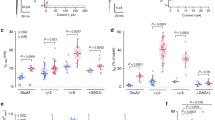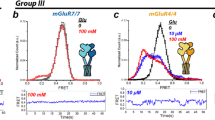Abstract
Ligand-gated ion channels transduce chemical signals into electrical impulses by opening a transmembrane pore in response to binding one or more neurotransmitter molecules. After activation, many ligand-gated ion channels enter a desensitized state in which the neurotransmitter remains bound but the ion channel is closed. Although receptor desensitization is crucial to the functioning of many ligand-gated ion channels in vivo, the molecular basis of this important process has until now defied analysis. Using the GluR2 AMPA-sensitive glutamate receptor, we show here that the ligand-binding cores form dimers and that stabilization of the intradimer interface by either mutations or allosteric modulators reduces desensitization. Perturbations that destabilize the interface enhance desensitization. Receptor activation involves conformational changes within each subunit that result in an increase in the separation of portions of the receptor that are linked to the ion channel. Our analysis defines the dimer interface in the resting and activated state, indicates how ligand binding is coupled to gating, and suggests modes of dimer–dimer interaction in the assembled tetramer. Desensitization occurs through rearrangement of the dimer interface, which disengages the agonist-induced conformational change in the ligand-binding core from the ion channel gate.
This is a preview of subscription content, access via your institution
Access options
Subscribe to this journal
Receive 51 print issues and online access
$199.00 per year
only $3.90 per issue
Buy this article
- Purchase on Springer Link
- Instant access to full article PDF
Prices may be subject to local taxes which are calculated during checkout





Similar content being viewed by others
References
Jones, M. V. & Westbrook, G. L. The impact of receptor desensitization on fast synaptic transmission. Trends Neurosci. 19, 96–101 (1996)
Clark, R. B., Knoll, B. J. & Barber, R. Partial agonists and G-protein coupled receptor desensitization. Trends Pharmacol. Sci. 20, 279–286 (1999)
Katz, B. & Thesleff, S. A study of the ‘desensitization’ produced by acetylcholine at the motor end-plate. J. Physiol. (Lond.) 138, 63–80 (1957)
Dingledine, R., Borges, K., Bowie, D. & Traynelis, S. F. The glutamate receptor ion channels. Pharmacol. Rev. 51, 7–61 (1999)
Mayer, M. L. & Partin, K. M. in Excitatory Amino Acids and Synaptic Function (eds Wheal, H. & Thomson, A.) 89–98 (Academic, New York, 1995)
Kiskin, N. I., Krishtal, O. A. & Tsyndrenko, A. Y. Excitatory amino acid receptors in hippocampal neurons: kainate fails to desensitize them. Neurosci. Lett. 63, 225–230 (1986)
Mayer, M. L. & Vyklicky, L. Concanavalin A selectively reduces desensitization of mammalian neuronal quisqualate receptors. Proc. Natl Acad. Sci. USA 86, 1411–1415 (1989)
Trussell, L. O., Thio, L. L., Zorumski, C. F. & Fischbach, G. D. Rapid desensitization of glutamate receptors in vertebrate central neurons. Proc. Natl Acad. Sci. USA 85, 4562–4566 (1988)
Colquhoun, D., Jonas, P. & Sakmann, B. Action of brief pulses of glutamate on AMPA/kainate receptors in patches from different neurons of rat hippocampal slices. J. Physiol. (Lond.) 458, 261–287 (1992)
Hausser, M. & Roth, A. Dendritic and somatic glutamate receptor channels in rat cerebellar Purkinje cells. J. Physiol. (Lond.) 501, 77–95 (1997)
Hall, R. A., Kessler, M., Quan, A., Ambros-Ingerson, J. & Lynch, G. Cyclothiazide decreases [3H]AMPA binding to rat brain membranes: evidence that AMPA receptor desensitization increases agonist affinity. Brain Res. 628, 345–348 (1993)
Rosenmund, C., Stern-Bach, Y. & Stevens, C. F. The tetrameric structure of a glutamate receptor channel. Science 280, 1596–1599 (1998)
Laube, B., Kuhse, J. & Betz, H. Evidence for a tetrameric structure of recombinant NMDA receptors. J. Neurosci. 18, 2954–2961 (1998)
Stern-Bach, Y., Russo, S., Neuman, M. & Rosenmund, C. A point mutation in the glutamate binding site blocks desensitization of AMPA receptors. Neuron 21, 907–918 (1998)
Patneau, D. K., Vyklicky, L. & Mayer, M. L. Hippocampal neurons exhibit cyclothiazide-sensitive rapidly desensitizing responses to kainate. J. Neurosci. 13, 3496–3509 (1993)
Stern-Bach, Y. et al. Agonist selectivity of glutamate receptors is specified by two domains structurally related to bacterial amino acid-binding proteins. Neuron 13, 1345–1357 (1994)
Kuusinen, A., Arvola, M. & Keinänen, K. Molecular dissection of the agonist binding site of an AMPA receptor. EMBO J. 14, 6327–6332 (1995)
Armstrong, N., Sun, Y., Chen, G.-Q. & Gouaux, E. Structure of a glutamate-receptor ligand-binding core in complex with kainate. Nature 395, 913–917 (1998)
Armstrong, N. & Gouaux, E. Mechanisms for activation and antagonism of an AMPA-sensitive glutamate receptor: Crystal structures of the GluR2 ligand binding core. Neuron 28, 165–181 (2000)
Sommer, B. et al. Flip and flop: A cell-specific functional switch in glutamate-operated channels of the CNS. Science 249, 1580–1585 (1990)
Gallivan, J. P. & Dougherty, D. A. Cation-pi interactions in structural biology. Proc. Natl Acad. Sci. USA 96, 9459–9464 (1999)
Cordi, A. A. et al. Identification and characterization of the isomers of cyclothiazide responsible for potentiating AMPA current. Bioorg. Med. Chem. Lett. 4, 1957–1960 (1994)
Partin, K. M. Domain interactions regulating AMPA receptor desensitization. J. Neurosci. 21, 1939–1948 (2001)
Partin, K. M., Bowie, D. & Mayer, M. L. Structural determinants of allosteric regulation in alternatively spliced AMPA receptors. Neuron 14, 833–843 (1995)
Partin, K. M., Fleck, M. W. & Mayer, M. L. AMPA receptor flip/flop mutants affecting deactivation, desensitization, and modulation by cyclothiazide, aniracetam, and thiocyanate. J. Neurosci. 16, 6634–6647 (1996)
Mayer, M. L., Olson, R. & Gouaux, E. Mechanisms for ligand binding to GluR0 ion channels: crystal structures of the glutamate and serine complexes and a closed apo state. J. Mol. Biol. 311, 815–836 (2001)
Regalado, M. P., Villarroel, A. & Lerma, J. Intersubunit cooperativity in the NMDA receptor. Neuron 32, 1085–1096 (2001)
Wo, Z. G. & Oswald, R. E. Unraveling the modular design of glutamate-gated ion channels. Trends Neurosci. 18, 161–168 (1995)
Wood, M. W., VanDongen, H. M. & VanDongen, A. M. Structural conservation of ion conduction pathways in K channels and glutamate receptors. Proc. Natl Acad. Sci. USA 92, 4882–4886 (1995)
Doyle, D. A. et al. The structure of the potassium channel: molecular basis of K+ conduction and selectivity. Science 280, 69–77 (1998)
Chen, G.-Q., Cui, C., Mayer, M. L. & Gouaux, E. Functional characterization of a potassium-selective prokaryotic glutamate receptor. Nature 402, 817–821 (1999)
Panchenko, V. A., Glasser, C. R. & Mayer, M. L. Structural similarities between glutamate receptors channels and K+ channels examined by scanning mutagenesis. J. Gen. Physiol. 117, 345–360 (2001)
Goodsell, D. S. & Olson, A. J. Structural symmetry and protein function. Annu. Rev. Biophys. Biomol. Struct. 29, 105–153 (2000)
Kuusinen, A., Abele, R., Madden, D. R. & Keinänen, K. Oligomerization and ligand-binding properties of the ectodomain of the α-amino-3-hydroxy-5-methyl-4-isoxazole propionic acid receptor subunit GluRD. J. Biol. Chem. 274, 28937–28943 (1999)
Ayolan, G. & Stern-Bach, Y. Functional assembly of AMPA and kainate receptors is mediated by several discrete protein–protein interactions. Neuron 31, 103–113 (2001)
Abele, R., Keinänen, K. & Madden, D. R. Agonist-induced isomerization in a glutamate receptor ligand-binding domain: a kinetic and mutagenic analysis. J. Biol. Chem. 275, 21355–21363 (2000)
Nagarajan, N., Quast, C., Boxall, A. R., Shahid, M. & Rosenmund, C. Mechanism and impact of allosteric AMPA receptor modulation by the ampakine CX546. Neuropharmacology 41, 650–663 (2001)
Otwinowsky, Z. & Minor, W. Processing of X-ray diffraction data collected in oscillation mode. Methods Enzymol. 276, 307–326 (1997)
Navaza, J. AMoRe: An automated package for molecular replacement. Acta Crystallogr. A 50, 157–163 (1994)
Brunger, A. T. et al. Crystallography & NMR system: A new software suite for macromolecular structure determination. Acta Crystallogr. D 54, 905–921 (1998)
Jones, T. A. & Kjeldgaard, M. Electron-density map interpretation. Methods Enzymol. 277, 173–208 (1997)
Kleywegt, G. J. & Jones, T. A. A super position. CCP4/EST-EACBM Newsl. Prot. Crystallogr., 9–14 (1994)
Collaborative Computational Project, Number 4 The CCP4 suite: programs for protein crystallography. Acta Crystallogr. D 50, 760–763 (1994)
Ansevin, A. T., Roark, D. E. & Yphantis, D. A. Improved ultracentrifuge cells for high-speed sedimentation equilibrium studies with interference optics. Anal. Biochem. 34, 237–261 (1970)
Johnson, M. L., Correia, J. J., Yphantiz, D. A. & Halvorson, H. R. Analysis of data from the analytical ultracentrifuge by nonlinear least-squares techniques. Biophys. J. 36, 575–588 (1981)
Chen, C. & Okayama, H. High-efficiency transformation of mammalian cells by plasmid DNA. Mol. Cell. Biol. 7, 2745–2752 (1987)
Acknowledgements
We thank L. Lu and C. Glasser for technical assistance, J. Lidestri for maintenance of the X-ray laboratory at Columbia University, and W. N. Zagotta and S. Harrison for helpful discussions. Synchrotron diffraction data were collected at the x4a beamline at the National Synchrotron Light Source. The XL-I ultracentrifuge was obtained with funds provided by the NIH. This work was supported by the Klingenstein Foundation (E.G.), the National Alliance for Research on Schizophrenia and Depression (E.G) and the NIH (E.G., M.L.M.). E.G. is also an assistant investigator of the Howard Hughes Medical Institute.
Author information
Authors and Affiliations
Corresponding authors
Ethics declarations
Competing interests
The authors declare that they have no competing financial interests
Rights and permissions
About this article
Cite this article
Sun, Y., Olson, R., Horning, M. et al. Mechanism of glutamate receptor desensitization. Nature 417, 245–253 (2002). https://doi.org/10.1038/417245a
Received:
Accepted:
Issue Date:
DOI: https://doi.org/10.1038/417245a
This article is cited by
-
GluN2A and GluN2B NMDA receptors use distinct allosteric routes
Nature Communications (2021)
-
Allosteric coupling of sub-millisecond clamshell motions in ionotropic glutamate receptor ligand-binding domains
Communications Biology (2021)
-
Strictly regulated agonist-dependent activation of AMPA-R is the key characteristic of TAK-653 for robust synaptic responses and cognitive improvement
Scientific Reports (2021)
-
Perspective on liquid metal enabled space science and technology
Science China Technological Sciences (2020)
-
Homomeric GluA2(R) AMPA receptors can conduct when desensitized
Nature Communications (2019)
Comments
By submitting a comment you agree to abide by our Terms and Community Guidelines. If you find something abusive or that does not comply with our terms or guidelines please flag it as inappropriate.



